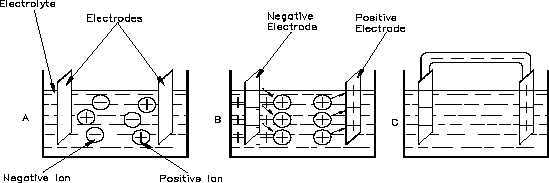DC SOURCES
Basic DC Theory
Figure 1 Basic Chemical Battery
Due to this action, electrons are deposited on the electrode, and positive ions from the electrode
pass into the electrolyte solution (Part B). This causes a negative charge on the electrode and
leaves a positive charge in the area near the electrode (Part C).
The positive ions, which were produced by ionization of the electrolyte, are repelled to the other
electrode. At this electrode, these ions will combine with the electrons. Because this action
causes removal of electrons from the electrode, it becomes positively charged.
DC Generator
A simple DC generator consists of an armature coil with a single turn of wire. The armature coil
cuts across the magnetic field to produce a voltage output. As long as a complete path is present,
current will flow through the circuit in the direction shown by the arrows in Figure 2. In this
coil position, commutator segment 1 contacts with brush 1, while commutator segment 2 is in
contact with brush 2.
Rotating the armature one-half turn in the clockwise direction causes the contacts between the
commutator segments to be reversed. Now segment 1 is contacted by brush 2, and segment 2 is
in contact with brush 1.
ES-02
Page 2
Rev. 0



